#airmindedness
Text

"This little girl has no doubt heard of the part women are playing in aeronautics, and plays at being an air-woman with all due seriousness. She is seen preparing her machine for its flight."
- from the Kingston Whig-Standard. May 27, 1933. Page 12.
#aviation#early aviation#1930s aviation#female aviator#model plane#human interest story#airmindedness#the great depression#wire photo
3 notes
·
View notes
Text
“Is it always like this?”
“Always like what?” I responded.
It was a beautiful late summer day in northern Virginia, or should I say, over northern Virginia – 2,500 feet above some of the battlefields that shaped American history. I was flying in support of the Experimental Aircraft Association’s Young Eagles program, carrying three Boy Scouts in my 1967 Cessna O-2A. Departing Manassas, the mountains guarding the Shenandoah Valley some 20 miles to the west were crystal clear, the mid-morning air was smooth, and we had just cleared the Washington, DC, Special Flight Rules Area. The voice came from the back right seat, “Everything is so green!”
A half dozen thoughts raced through my head in as many seconds before I answered. “Yes,” I said with a chuckle, “it is always like this… except when you can’t see it because of clouds… or it is wild with colors in the fall or white in the winter.”
“I had no idea,” he said, “that there were so many farms and trees.”
Taking a kid for an airplane ride is one of the most satisfying flights any pilot can make.
This was from a Boy Scout. Someone, who, one would imagine, spent a lot of time out among the fields and woods. Nonetheless, he was surprised how much of the area he lived in was still “green” and how little, comparatively speaking, consisted of roads, buildings, and other cement or asphalt.
That was not the first time I heard a young person express wonder at seeing what their world looked like from above. This time, though, it made me ask myself if I somehow lost that wonder. I often take pleasure in looking at the ground below me on fair weather days. I notice how different farmers choose to arrange their fields, wonder how in the world aerial application pilots handle the growing number of wind turbines, ponder where the river barges and locomotives are coming from, where they are going, and what they are carrying. But the wonder of it all! Have I really taken for granted how so very lucky I am to see the world in a way that so very few people can enjoy?
The purpose of programs like the EAA Young Eagles and Civil Air Patrol Cadet orientation flights are to introduce our youth to aviation. It is not only a good thing to do in and of itself. It is essential if we are to pass on our aviation heritage so that it can continue and develop through the future. Sometimes, though, I think we focus too much on the airplane or on piloting, and not enough on flying. In other words, inspiring our youth with the wonder of flight. Showing them that they can be a pilot is part of it. It is certainly not enough, and I am not even sure that piloting is where to begin.
Let’s be honest and admit that becoming a pilot isn’t for everyone. Statistically, it is for very few. Flying is expensive – in time as well as money. Kids have other things demanding that time and attention. Becoming a pilot is something that – well, if it isn’t relevant in the next two years, then it is way outside of most kids’ event horizon. A load of school work (that bears no relation to what I had in school), sports, video games, friends, family life, and – yes, Boy Scouts, Girl Scouts, Civil Air Patrol, and other youth programs – all compete for time, attention, and resources. Instructing a boy or girl on why and how an airplane flies or controlling one in flight may provide momentary interest, but is it enough to inspire them? Could it even be too much?
On another flight I let a teenage girl handle the controls. She was very good and quickly understood the relationship of ailerons, rudders, elevator, and horizon. After just a few minutes, however, she asked if I would take back the controls. She just wanted to look out the window. From time to time I have also seen a Young Eagle ask to sit in the back, camera in hand. I fly for the Civil Air Patrol, as well, and I have asked CAP cadets about their orientation rides. I was surprised to hear that many prefer the back seat. They said that when they are in the front seat, the pilot has to teach or show them certain things and they are expected to perform certain tasks in return. Sitting in back they can take pictures, look out the window, or listen to the instruction up front as they wish and when they wish. There is a lesson here crying to be learned.
Not every one of these young Americans are future pilots. They come because they are interested in flight. There is a difference. The goal is not turning those young Americans into Air Cadets. We are introducing them to the wonder of flight. Some may be inspired to start flight training right away. For others, we might plant a seed that will sprout on its own, and unexpectedly, many years from now. Others may choose another aviation related field – or something else entirely. For all of them, we should try to provide an enjoyable and memorable experience. Our goal should be to give our future (and that is what these young Americans are – our future) the opportunity to become airminded.
That word, according to the Oxford Dictionary of the English Language, means “an interest in and enthusiasm for aircraft.” The idea was promoted in America by Billy Mitchell as early as 1921. He meant something more than that dictionary definition. To borrow from current U.S. Air Force Doctrine, airmindedness is a perspective that allows a person to perceive their world unconstrained by geography, distance, location, or time. That is the magic of flight. That is the wonder. That is why these Young Eagles come to us, whether they know it or not. That is what we should offer to them.
“Is it always like this?” Yes, my heart always leaps every time the wheels leave the pavement.
The post “Is it always like this?” appeared first on Air Facts Journal.
from Engineering Blog https://airfactsjournal.com/2018/09/is-it-always-like-this/
0 notes
Photo
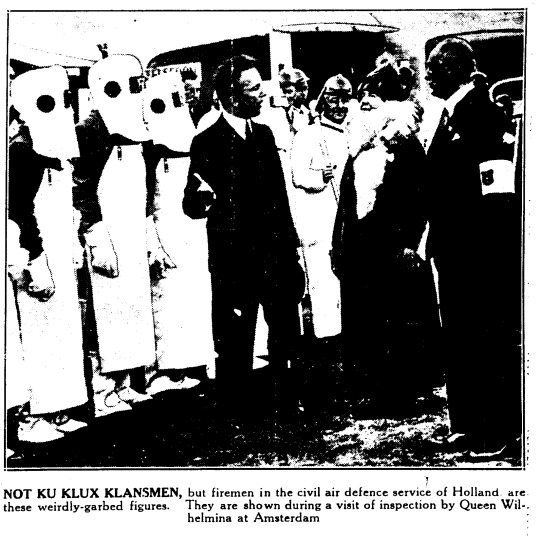
“Not Ku Klux Klansmen, but firemen in the civil air defence service of Holland are these weirdly-garbed figures. They are shown during a visit of inspection by Queen Wilhelmina at Amsterdam.”
- from the Toronto Star, October 26, 1939. Page 25.
#amsterdam#netherlands#queen wilhelmina#air raid#civil air defence#air raid precaution#gas masks#death from the air#aerial bombardment#world war II#phoney war#airmindedness#ku klux klan#holland
2 notes
·
View notes
Photo
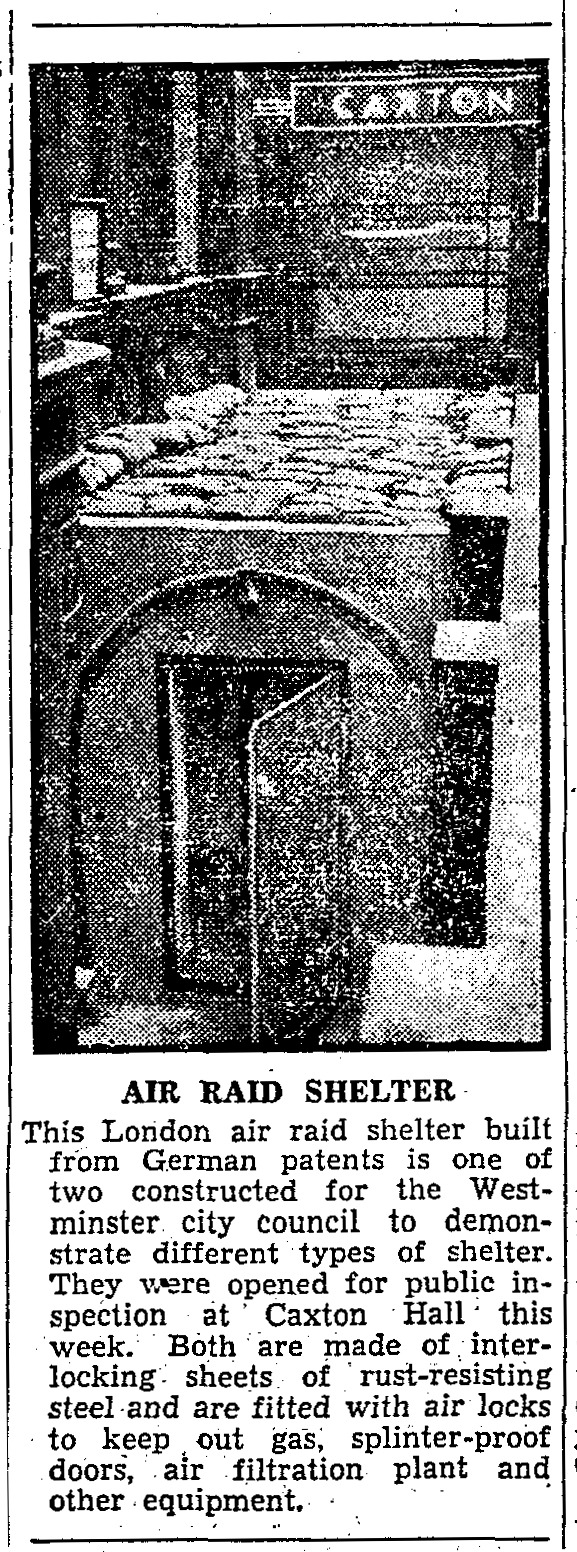
“Air Raid Shelter,” Toronto Star. February 16, 1938. Page 03.
----
This London air raid shelter built from German patents is one of the two constructed for the Westminster city council to demonstrate different types of shelter. They were opened for public inspection at Caxton Hall this week. Both are made of interlocking sheets of rust-resisting steel and are fitted with air locks to keep out gas, splinter-proof doors, air filtration plant and other equipment.
#london#westminster#air raid precaution#air raid shelter#terror from the air#road to world war II#lead up to world war 2#airmindedness#united kingdom
0 notes
Photo
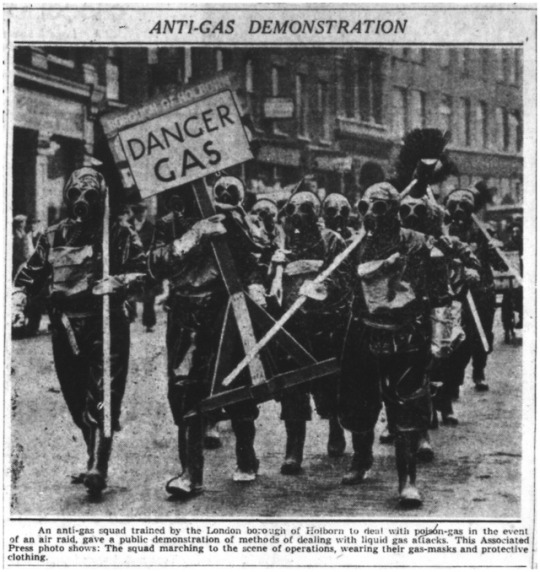
“Anti-Gas Demonstration,” Montreal Star. January 29, 1937. Page 05.
“An anti-gas squad trained by the London borough of Holborn to deal with poison-gas in the event of an air raid, gave a public demonstration of methods of dealing with liquid gas attacks. This Associated Press photo shows: The squad marching to the scene of operations, wearing their gas-masks and protective clothing.”
#gas masks#chemical warfare#poison gas#air raid#london#civil defence#air defence#air raid precautions#aerial warfare#aerial bombardment#terror from the air#anti-gas squad#fear of the bomber#the bomber will always get through#airmindedness#preparation for the end times#road to world war 2#lead up to world war 2
2 notes
·
View notes
Photo
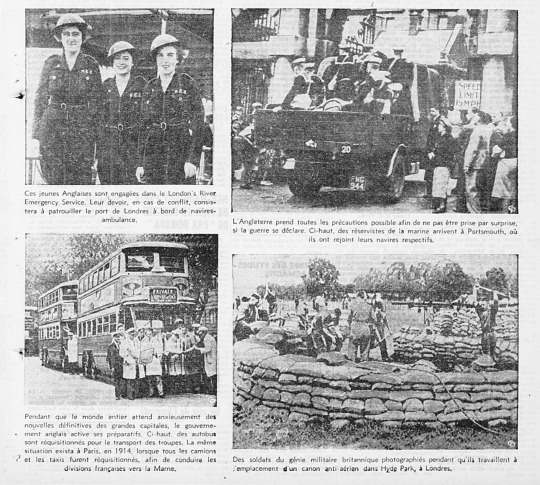
Scenes from England just before the Second World War - during the ‘Danzig Crisis’ - from L’Illustration Nouvelle. August 29, 1939. Page 01.
Top Left: “Ces jeunes Anglaises sont engagées dans le London's River
Emergency Service. Leur devoir, en cas de conflit, consistera à patrouiller le port de Londres à bord de navires ambulance.”
Top Right: “ L’Angleterre prend toutes les précautions possible afin de ne pas être prise par surprise, si la guerre se déclare. Ci-haut, des réservistes de la marine arrivent à Portsmouth, où ils ont rejoint leurs navires respectifs.”
Bottom Right: “Des soldats du génie militaire britannique photographiés pendant qu’ils travaillent à emplacement d’un canon anti aérien dans Hyde Park-, à Londres.”
Bottom Left: “Pendant que le monde entier attend anxieusement des nouvelles définitives des grandes capitales, le gouvernment anglais active ses préparatifs. Ci-haut, des autobus sont réquisitionnés pour le transport des troupes. La même
situation exista à Paris, en 1914. lorsque tous les camions et les taxis furent réquisitionnés, afin de conduire les divisions françaises vers la Marne.”
#great britain#war preparations#world war II#road to world war II#danzig crisis#mobilization#partial mobilization#naval reserves#coast guard#emergency services#anti-aircraft gun#anti-aircraft#airmindedness#military preparations#british army#royal navy
0 notes
Photo
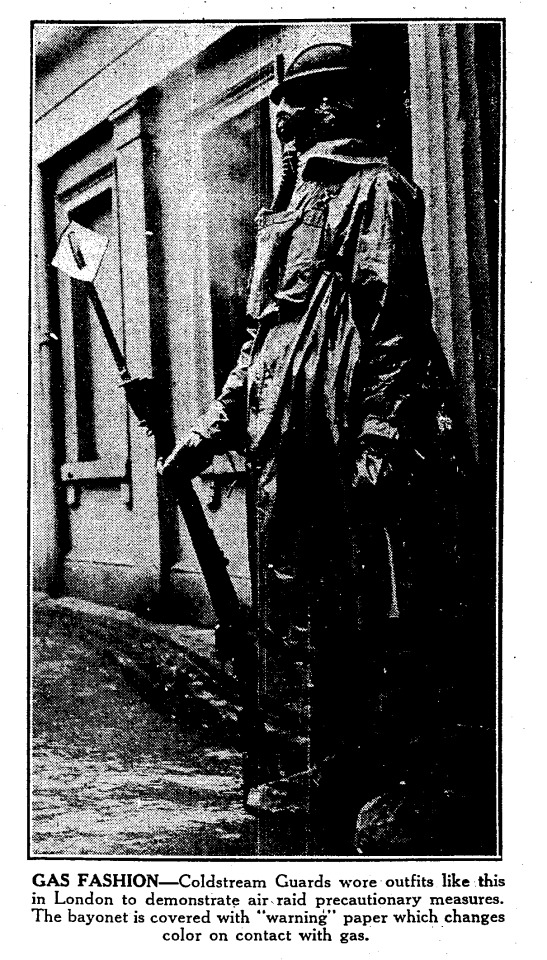
“Gas Fashion – Coldstream Guards wore outfits like this in London to demonstrate air raid precautionary measures. The bayonet is covered with ‘warning’ paper which changes color on contact with gas.
- from the Toronto Star, February 18, 1938. Page 25.
#coldstream guards#gas mask#gas outfit#air raid#civil air defence#air raid precaution#death from the air#aerial bombardment#gas warfare#chemical warfare#airmindedness#road to world war II
0 notes
Photo

“British Government Opens Mask Factory,” Montreal Gazette. January 22, 1937. Page 19.
“Gerald Palmer (left), Geoffrey Lloyd, Home Office Under-Secretary, and Wing Commander Hodsell in charge of the air raid precautions department (right), pictures as they attended the recent opening of the first British Government factory for the manufacture of gas masks. When the factory is going full blast it will turn out masks at the rate of 500,00 a week. The officials are wearing some of the masks, which are proof against any gas so far known for use in war.”
#gas mask#chemical warfare#aerial warfare#air raid precautions#civil defence#gas mask factory#aerial bombardment#terror from the air#air raids#air war#road to world war 2#lead up to world war 2#airmindedness
0 notes